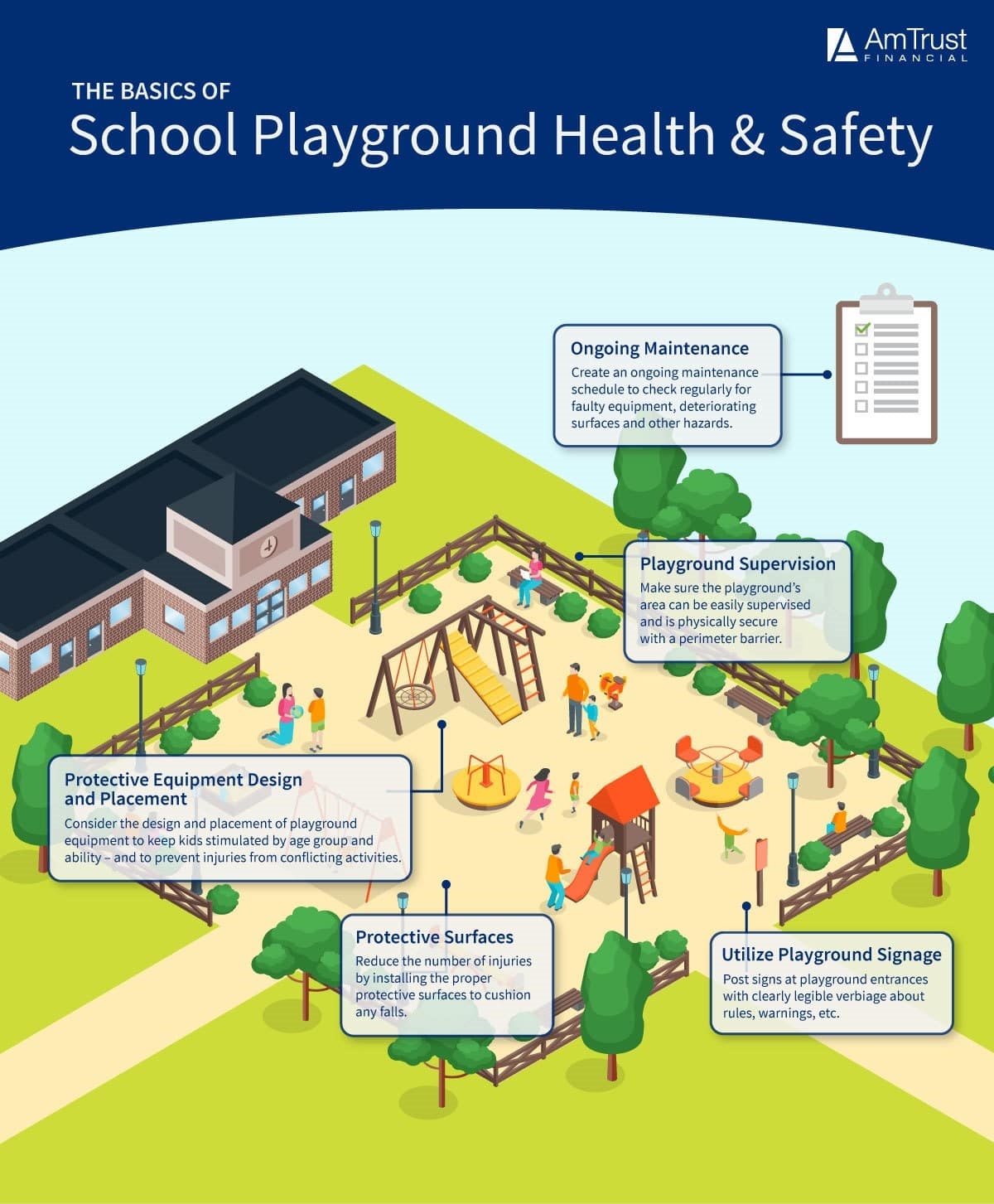The Basics of Playground Health & Safety
Everyone loves a good time at the playground, but adults know that it’s not fun and games when someone gets injured. The Consumer Product Safety Commission (CPSC) estimates that there are more than 200,000 injuries associated with playgrounds annually from falls, equipment-related hazards and more. The CDC also reports more than 20,000 children younger than age 14 visit the emergency room every year due to playground-related traumatic brain injuries.
There is an inherent risk in participating in playground games that we’re all aware of, but there are several actions daycares, preschools, private and public schools, churches, and youth programs can take to significantly reduce the risk of children getting hurt while they’re having a good time.
How Can You Be Safe on a Playground?

The CPSC and other safety organizations have developed a loss control program for playgrounds that emphasizes the importance of playground supervision, protective surfaces, proper equipment design and placement and ongoing maintenance tasks. Let’s take a closer look at each element and how your organization
can ensure a safe and fun experience for kids of all ages.
Preventing Playground Injuries
Playground Supervision
Supervision is at the top of the playground safety rules list. The equipment’s layout must not have any visual barriers that might prevent chaperones from seeing all of the playground at once. Install a perimeter barrier that surrounds the playground; this keeps children from wandering off and also keeps the area secure when it’s not in use. Physically secure and set up the area for fun, safe experiences.
Utilize Playground Signage
Make sure signs are posted at playground entrances, or are clearly legible around the playground. Signage on playground equipment should include warnings and verbiage such as:
- Residents and guests only
- Children must be supervised
- Permissible hours of operation
- Age range of the playground user
- The name of the manufacturer and/or designer
- Report any exposed hard surfaces, damaged equipment, or improper behaviors

Protective Surfaces
Playground protection in the form of rubber composite or loose-fill ground covering – think sand and mulch – will help cushion falls and reduce the number of bumps and bruises. Surfaces like concrete or asphalt should never be used directly under playground equipment, and even grass and dirt don’t do enough to keep children safe from harm. This is because environmental factors and general wear and tear can reduce their shock-absorbing effectiveness over time.
It’s also important to ensure loose-fill is installed in the proper amount in addition to using the correct protective surfaces. The minimum compressed loose-fill surfacing depths vary by the material used. Sand, pea gravel, wood mulch or wood chips should be at least nine inches thick to help prevent injuries from falls at four to ten feet up. Check out the CPSC’s
Public Playground Safety Handbook for more information.
Proper Equipment Design and Placement
Playground equipment should be designed to stimulate children and help them learn new skills, but it’s important to keep in mind that different age groups have different needs and abilities. Consider setting up separate areas for toddlers and older kids to help ensure there are no run-ins that may cause injury. Organize the playground into areas to help prevent injuries caused by conflicting activities. For example, don’t place swings in a way that will cause swinging feet to bump into others’ heads, and sandboxes shouldn’t be near ball fields where flying balls present the possibility of an accident. All equipment should be properly assembled and inspected by a qualified person before use.
Ongoing Maintenance
Regular inspections and ongoing maintenance of all playground equipment can help ensure the safety of the children enjoying the area. Create a comprehensive maintenance schedule to detect any deterioration of equipment or surfaces as well as any hazards that may have developed. Watch for things like loose bolts, cracks in plastic, worn, rotting or missing parts, rusted metal, and so on. Attend to any deficiencies immediately because worn parts and structural deteriorations can lead to disastrous injury scenarios.

AmTrust’s Comprehensive Suite of Specialty Insurance Products for Nonprofit Organizations
It’s impossible to prevent every type of accident from occurring on a playground, but by following these playground safety tips you can help reduce the risk of children getting injured.
Nonprofit insurance coverage from AmTrust can be tailored to the needs of your organization, with insurance lines that include property, general, professional, management, umbrella liability, workers’ compensation and more. For more information, please
contact us today.
This material is for informational purposes only and is not legal or business advice. Neither AmTrust Financial Services, Inc. nor any of its subsidiaries or affiliates represents or warrants that the information contained herein is appropriate or suitable for any specific business or legal purpose. Readers seeking resolution of specific questions should consult their business and/or legal advisors. Coverages may vary by location. Contact your local RSM for more information.